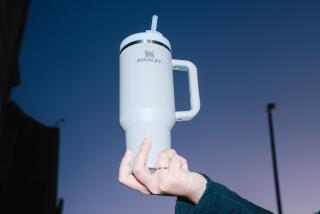Upper Midwest takes stock in fiberglass fauna : Homeowners embellish yards with replicas of favorite farm animals. Cheeseburgers turn up, too. One area has become the Silicon Valley of such statuary.
- Share via
SPARTA, Wis. — When Harvey Wallhoffer retired from farming and sold his livestock a couple of years ago, he quickly discovered he missed a few things. Like the cows and the chickens.
So Wallhoffer and his wife, Angela, drove across the state here to Sparta and picked up the next best thing--a full-sized fiberglass cow ($2,000) and a six-foot-tall fiberglass rooster ($2,000). Just for fun, they also threw in a three-foot-high fiberglass elephant ($1,000) that squirts water through its trunk. Nice touch for the grand kids.
The synthetic menagerie was last seen grazing on the grass outside the Wallhoffers’ front door.
“He doesn’t have the cows any more, so that’s like his cow out here now,” explained Angela Wallhoffer from her home in rural Allenton, Wis., 40 miles northwest of Milwaukee. “It’s so lifelike.”
Contrary to the stereotypes held by snobby outsiders, Wisconsinites are not all given to swigging beer and wearing large plastic foam cheese wedges on their heads at nationally televised political conventions and Green Bay Packers football games. Many of them are also partial to huge displays of plastic livestock and the like.
To be fair, the phenomenon is not confined to Wisconsin. The landscape throughout the upper Midwest is littered with fiberglass fauna, not to mention larger-than-life fiberglass replicas of fish, lumberjacks, corn stalks and cheeseburgers.
But the credit, or blame, for all this is directly traceable to this small community near the Mississippi River that has become something of the Silicon Valley of fiberglass statuary. “Business is booming, even in the recession,” bragged Jerry Vettrus, president of FAST Corp., which claims to be the leading, if not the only, purveyor of such products in the field.
FAST, which stands for Fiberglass Animals, Shapes and Trademarks, is the latest in a succession of Sparta-based firms that over the last three decades have produced what may be the world’s largest and most varied monuments to artificiality.
Craftsmen from Sparta are responsible for such masterpieces as the mascot outside the Freshwater Fishing Hall of Fame in Hayward, Wis., a $200,000 plastic muskie that is 145-feet long, four-stories tall and hollow inside so tourists can walk through it. Another Sparta creation: a 50-foot high Jolly Green Giant that greets visitors entering Blue Earth, Minn.
Sprawled across an acre lot outside the FAST factory lie the molds for more than 360 of the firm’s fiberglass creations, from a 21-foot-long dinosaur to a bat with a 12-foot wingspan and an eight-foot-high octopus swing. There are frogs and pelicans with water slide tongues, giraffes, ice cream cones, Vikings, rhinoceroses, steers, bulls and other animals.
The bulk are destined for miniature golf courses as well as amusement and water parks both in the United States and as far away as Hong Kong and Japan. But a large number, such as a huge custom-designed cow wearing sunglasses, also turn up as logos for restaurants and other Midwestern businesses.
Also on the premises are immense cardinals, warriors and bulldogs galore for high school mascots, as well as distinctive landmarks made for many cities in the region. One recent order is from a Minnesota town that wants work done on a 17-foot statue of Paul Bunyan’s girlfriend, Lucette.
There also are the pigs, cows, chickens, deer and horses that homeowners favor. Just why people in these parts scatter fiberglass animal replicas around their spreads is a little unclear. But, believe it or not, there are people who study such things. One of them, James Curtis, is an urban cultural geographer at Oklahoma State University whose field of expertise is yard ornaments. Curtis theorized that Americans perceive their yards as sort of a buffer between the sanctuaries of their homes and the sometimes cruel, threatening world on the outside.
“In its role as a middle ground, we embellish it with certain elements that reflect aspects of who we are as people individually and perhaps who we are collectively as a society,” he explained.
Which brings us back to the elephant that squirts water and its plastic barnyard buddies at the Wallhoffers’ place. People are constantly stopping by to ask where they can get their own, Angela Wallhoffer confided, though an occasional crank will poke fun.
“We just tell them, ‘You spend your money the way you want to and we’ll spend ours the way we want to,’ ” she continued. “These give us a lot of pleasure.”
More to Read
Sign up for Essential California
The most important California stories and recommendations in your inbox every morning.
You may occasionally receive promotional content from the Los Angeles Times.










